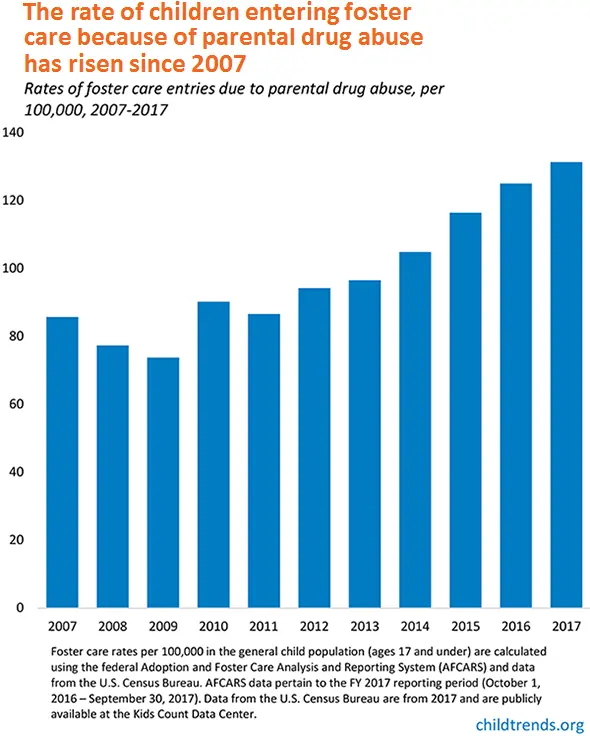In federal fiscal year (FY) 2017, the rate of children entering foster care due to parental drug abuse rose for the sixth consecutive year to 131 per 100,000 children nationally—a 5 percent increase from the previous fiscal year and a 53 percent increase since FY 2007. Of the 268,212 children under age 18 removed from their families in FY 2017, 96,400 (36 percent) had parental drug abuse listed as a reason for their removal.

Child Trends’ analysis of FY 2016 and FY 2017 data from the Adoption and Foster Care Reporting System (AFCARS) also shows that most states (35) experienced an increase in both the number and rate of children entering foster care due to parental drug abuse.

Six states and territories—Puerto Rico, Wyoming, New York, South Dakota, Wisconsin, and Ohio—saw the largest rate increases; New Hampshire, Louisiana, Arizona, and the District of Columbia had the largest decreases. However, foster care entry rates may increase for reasons other than increases in parental drug abuse. For example, some states may have implemented new policies or practices that help them better identify children in need of child welfare services, resulting in a larger number of children coming into care due to parental drug abuse.
Nationally, neglect is the most common reason for removal (62 percent), but these cases often involve other underlying factors such as drug or alcohol abuse or parental mental health problems, which may not be reported or even known by child welfare agencies at the time of removal. The threshold for indicating parent drug abuse as a reason for removal varies among, and sometimes within, states. For example, some states require a formal diagnosis of drug abuse for parental drug abuse to be listed as a reason for removal, while others maintain lower thresholds such as a positive urine screen or investigator suspicion. States also do not report data on informal arrangements in which a child stays with relatives or family friends without formally entering foster care.
Policy and media attention have focused on increased opioid use as the primary factor in the recent increase in the foster care population. According to a series of recent reports from the Office of the Assistant Secretary for Planning and Evaluation (U.S. Department of Health & Human Services), counties with higher rates of drug overdose deaths and hospitalizations also tend to have higher rates of maltreatment reports, larger caseloads, and more challenging and severe child welfare cases. And while, in 2017, opioids were involved in more drug overdose deaths (67 percent) than any other substance, there is little research on the specific influence of opioids on the child welfare system. One challenge to better understanding this relationship is that federal law does not require states to specify the type of drug abuse involved in a child’s removal from the home.
Despite growing knowledge about the influence of drug abuse on the child welfare system, challenges persist in addressing the problem. Many localities lack resources to provide appropriate treatment for parents battling addiction and struggle with a shortage in foster homes to care for children while their parents are in treatment. The 2018 Family First Prevention Services Act may provide some relief to states by making federal Title IV-E funding available to help families whose children are at risk of being removed. Expanded preventive services, including mental health and substance abuse services, could provide families with supports that prevent the need to remove their children.
Next month, our analysis of the FY 2017 foster care data will offer a closer look at younger children in foster care.
© Copyright 2025 ChildTrendsPrivacy Statement
Newsletter SignupLinkedInYouTubeBlueskyInstagram
